With the inauguration of Karnaphuli Tunnel, Bangladesh now has South Asia’s first ever underwater multi-lane tunnel. How is it going to help the Southern Bangladesh? Did Bangladesh really need a tunnel instead of another bridge?
Chattogram, the nation’s commercial capital, owes much of its economic vibrancy to its lifeline, the river Karnaphuli. The Chattogram Port, strategically located at the estuary of the Karnaphuli River, has closed its books, generating a net income of BDT 10.75 billion in the fiscal year 2022. During the same year, this prime port facilitated the handling of over 3 million containers, delineating Karnaphuli’s status as the most prominent navigable waterway with substantial economic benefits.
Karnaphuli’s Contribution to the Country
The country’s reliance on the Karnaphuli River, topped with its vital connection to the Bay of Bengal, has made it a magnet for global trade. This is not something that emerged with Bangladesh; the Karnaphuli has a very long history of contributing to global trade for this land. Legend has it that during the eighth and ninth centuries, Arab merchants used to bring “Karanphol“ (cloves) to Chattogram from hilly tracks in Sylhet with the intention of exporting them to Europe. Thus, eventually, the river started getting known as Karnaphuli.
Since the Karnaphuli is the gateway for Bangladesh to global trade, this advantageous positioning has attracted industry leaders, prompting them to establish economic powerhouses on both banks of the river, further contributing to the region’s economic growth and significance. BEPZA, being the official organ of the government to promote, attract, and facilitate foreign investment, manages two EPZs in Chattogram. One of which is KEPZ, or the Karnaphuli EPZ, which was also established on the bank of the river Karnaphuli. Besides these, this portion of the river is an integral part of Bangladesh Navy’s operations
Tale of Two Banks : Patenga and Anwara
The Karnaphuli Tunnel is built as a straight-line alternative to a bridge that would have connected Anwara with Patenga, which converge at the point where the Karnaphuli River meets the Bay of Bengal. This estuary has immense significance due to its vital role as the gateway for vessels to access the Bay of Bengal, resulting in significant maritime traffic throughout the year.
Patenga
On the Patenga side of the river, there is a picturesque tourist location, the Patenga Sea Beach. Due to being on the northern side, Patenga has direct connectivity to the center of Chattogram city. Thus, it has seamless access to the Chattogram Port and the Shah Amanat International Airport. Moreover, the Patenga side accommodates several industries and institutions, including the Karnaphuli Export Processing Zone (KEPZ). There are also cement factories, which have their own jetty to transport finished goods on the karnaphuli. Adjacent to the cement factories are three state-owned oil depots: The Padma Oil Company, which earned BDT 240.38 crore in the fiscal year of 2021–22; The Meghna Petrolium Ltd.; and the Jamuna Oil Company Ltd. The other organizations on this side are: the Eastern Refinery; the Chattogram Dry Dock for ship repairs; the Issa Khan Naval Base; the Coast Guard Base; and the Bangladesh Naval Academy. Notably, these industries and organizations heavily rely on the Karnaphuli River for their daily operations. The Patenga side also has direct access to Dhaka.
Anwara
The Anwara side of the river has direct access to Cox’s Bazar, the country’s premier tourist destination. Being on the southern part, Anwara has been granted access to the Matarbari Sea Port, Bangladesh’s first deep-sea port, further bolstering the country’s integrated development plan. In addition to this, Anwara is home to significant establishments such as the Bangladesh Marine Academy and state-owned entities like CUFL (Chattogram Urea Fertilizer Limited), which rank among the largest fertilizer manufacturers in Bangladesh. This company has the capacity to generate a profit of BDT 10 million daily if it runs regularly. In the fiscal year 2021, Bangladesh successfully exported fertilizers worth approximately $22.8 million.
Bottlenecks That the Karnaphuli Tunnel is Solving
However, prior to the construction of the Karnaphuli Tunnel, the connection between these two banks posed significant challenges. Travelers had to navigate to Kalurghat, the opposite part of the city, to use the Karnaphuli Bridge as the route between Patenga and Anwara, resulting in increased travel distances and heightened traffic congestion. Prior to the tunnel’s completion, the only practical way to cross the river in the shortest time was by boat, but strong tides frequently made this option difficult. There were often boat-sink accidents that caused deaths and casualties.
Moreover, no regular ferry service was available for crossing the river. Strong tides also make it impossible to operate ferry services. Due to the river’s confluence with the sea within close proximity, there is a very strong ebb and flow. This led to a limitation on vehicles crossing the river. Thus, both transportation of goods and passengers with cars had the only option of going to the other end of the town and crossing the river with the Karnaphuli bridge.
Prior to the Karnaphuli tunnel, those who wanted to visit Cox’s Bazar by road from Dhaka or other districts had to travel the same loop, going to Kalurghat and crossing the Karnaphuli bridge. This also lengthened the travel distance to Cox’s Bazar. For this reason, the same route to Kalurghat had both intercity and intracity vehicles at the same time, ultimately resulting in more traffic congestion.
The Kalurghat bridge was opened in 1931. Being almost a century old, it requires more maintenance. But more importantly, this bridge has a major caviar. Along with vehicles, the one-way bridge carries trains. The other side of the bridge is closed when traffic moves on one side. Thus, long traffic jams have been a problem as a result for more than three decades.
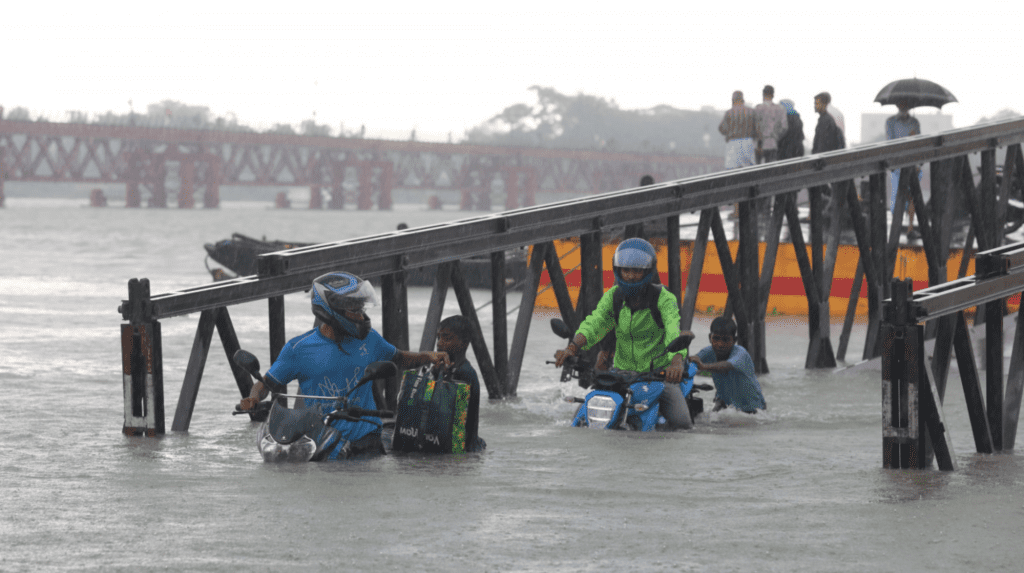
Why Not Another Bridge Instead of the Karnaphuli Tunnel?
As the Karnaphuli River has been providing easy access to the Bay of Bengal, its maritime advantages are endless. This navigable route has always been the lifeline for not only Chattogram Port but also for all the industries that have been built on both sides of the river. There are numerous jetties and terminals on this route that help the industries carry their goods. This route has also been the go-to for the Bangladesh Navy’s base located on the same bank as Chattogram Port. And for this reason, building a bridge over this route for connecting Anwara and Patenga would have destroyed Bangladesh’s prime seaport, naval defense, and other industries as well.
Chattogram Port
Naval Base
Jetties and Terminals
To keep the facilities provided by the Karnaphuli River intact and at the same time solve one of the largest hiccups in Chattogram, the government of Bangladesh decided to build the Bangabandhu Sheikh Mujibur Rahman Tunnel 150 feet under the Karnaphuli River. Being the only solution to the problem, this is also South Asia’s first underwater tunnel.
Coast-to-coast View of Karnaphuli Tunnel
Construction on this project began in March 2019 after Prime Minister Sheikh Hasina and Chinese President Xi Jinping announced it in October 2016.
Started in 2019, the construction of the Karnaphuli tunnel is now complete after four years. Unlike other urban development projects, this construction work did not bother the citizens because it was done under water and away from the locality.
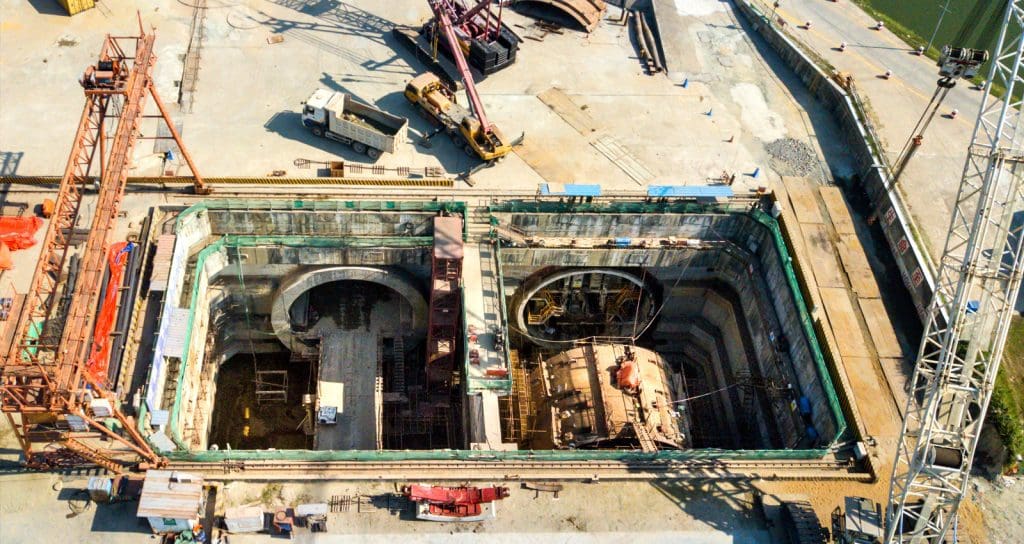
The Karnaphuli Tunnel is a 3.4-kilometer tunnel consisting of two tubes, 150 feet below sea level. Each of the tubes is 10.7m wide and has a height of 4.9m. This width and height will allow every type of vehicle to use the tunnel for crossing the river, which was previously impossible. Along with the 3.4 km of tubing, there will be an approach road of 5.4 km, and a 740-meter bridge will link it to the main city on the west. With the tunnel operational, the distance between Chattogram and Cox’s Bazar will be reduced by 40km. Vehicles traveling the tunnel will be able to run at a maximum speed of 60 km/h
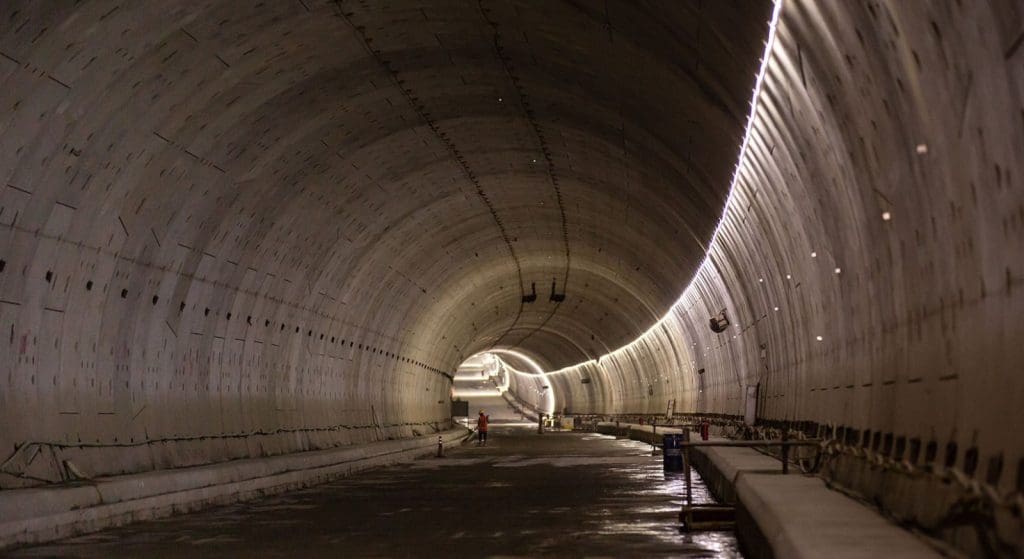
The tunnel imposes varying toll rates for different vehicle types. Private cars and pick-up trucks are charged a minimum toll of BDT 200, while microbuses pay BDT 250. Buses with fewer than 31 seats incur a BDT300 toll, while those with more than 32 seats are charged BDT400. Larger buses (3XL) are subject to a BDT 500 toll. Trucks carrying goods up to five tons pay BDT 400, eight-ton trucks are charged BDT 500, and 11-ton trucks pay BDT 600. The 3XL trailer toll is BDT 800, and the 4XL trailer is charged BDT 1,000, with an additional BDT 200 for each additional XL.
Engineering Hiccups
To make South Asia’s first underwater tunnel, engineers had to face numerous problems. Underwater soil conditions are not the same everywhere, making the boring of the tunnel difficult since ground support is crucial. As it is 150 feet below sea level, slurry pressure was constantly challenging the construction work. Due to being bored underwater, it was very difficult for tunnel boring machines (TBM) to maintain the grouting pressure. There was a very high risk of everything collapsing near the injection point, as it is considered very fragile. The team had to maintain high precision in its excavation work, with very little margin for error. To ensure this precision, they had to maintain simultaneous coordination with the TBM operators. SMEC, along with joint venture partners, was appointed for the work from design to supervision of the Karnaphuli tunnel.
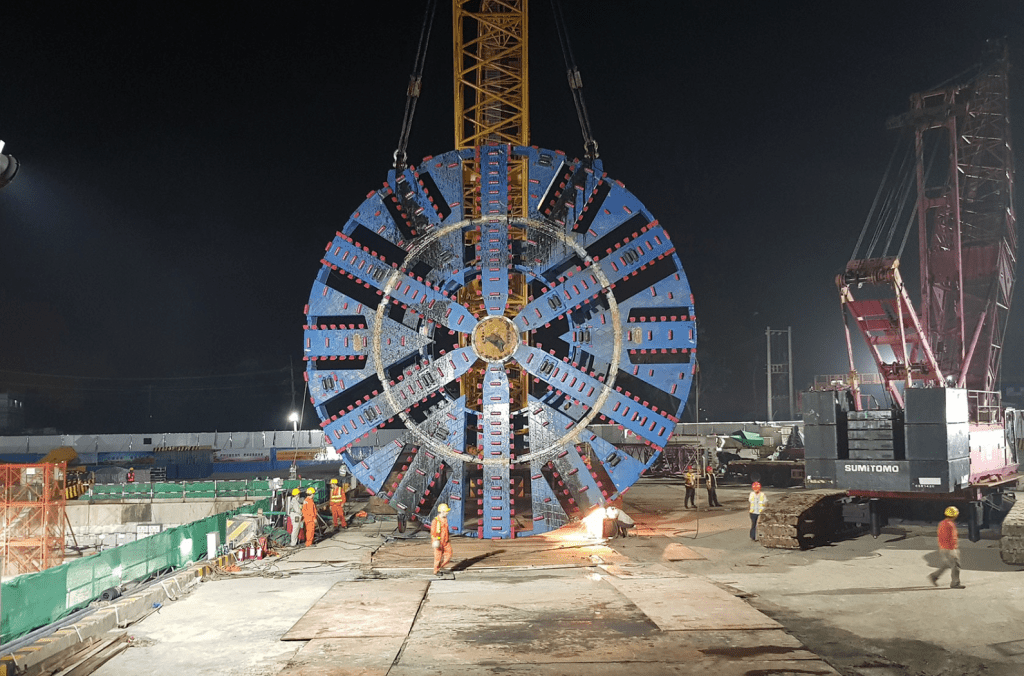
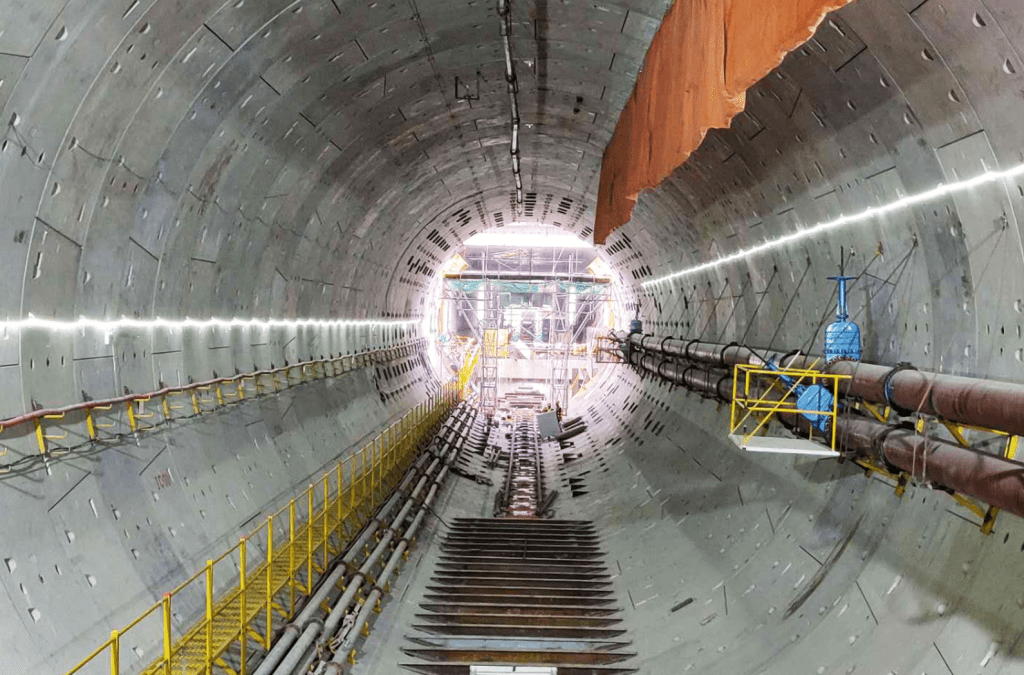
Finance and Economic Benefits of Karnaphuli Tunnel
The Karnaphuli Tunnel was built at a cost of BDT 103 billion. This project has been implemented with joint funding from the Governments of Bangladesh and China.
The Exim Bank of China has given a loan of BDT 59 billion with a 2% interest rate and a repayment period of 20 years. The government of Bangladesh provided the remaining amount.
The Karnaphuli tunnel has four different types of economic benefits, according to a feasibility study published by the Bangladesh Bridges Authority. The estimated number of staff for operations is around 250, and all of them are local. Thus, the total value-added contribution to the country’s economy is estimated at BDT 36 million per year. A Traffic Survey Analysis and Forecast Reports prepared by DevConsultants Ltd shows that, With the tunnel operational, it is expected to be able to handle more than 28,000 vehicles per day by 2025. And with a feasibility study, it is expected to handle 162,000 vehicles per day by 2067.
Number of Vehicles per Annum (Million)
Source: Feasibility Study Report Published by Bangladesh Bridge Authority in April 2013
No Data Found
Karnaphuli Tunnel was created to save time and travel distance. With saved time, each vehicle earns a value of time. Multiplying this with the projected traffic shows that the tunnel would earn $112.5 million/year by 2062.
Annual Time Savings (US$ million, 2012 prices)
Source: Estimates based on Feasibility Study of the Third Karnaphuli Bridge, Ministry of Economic Affairs, December 2001 and inflated current prices
No Data Found
Along with the value of time, the vehicle will incur fewer operational costs. By 2062, it is projected to save $12.9 million/year.
Annual Vehicle Operational Cost (US$ million, 2012 prices)
Source: Coast-to-coast View of Karnaphuli Tunnel
No Data Found
A Time and Budget Overrun Perspective
The Karnaphuli Tunnel was approved at the Ecnec as a multi-lane road tunnel project back in November 2015. And the construction of the main tunnel began in 2019. Initially, the entire project was set to open for traffic by December 2021. Eventually, after two overruns, it is now open two years later than originally scheduled. Although this overrun is big, looking at its scale and comparing it with other projects that incur multiple time overruns, it turns out to be much better. This also provides a scope to think whether the projects with less or no land acquisition tend to incur fewer time overruns.
Similarly, the initial budget of the project was BDT 84.5 billion. But later the project was revised with an increased cost at BDT 103.7 billion. This jump of BDT 19.2 billion is 22.72% of the original budget. Then again, considering that COVID-19 hit soon after the construction began and the dollar rates hiked, this mega project is probably the least overrun mega project so far. Further study on the implementation of this project compared to the other mega projects can reveal important insights on reducing cost and time overrun in mega projects.
Expectation
The narrow roads connecting to the Karnaphuli Tunnel may become a significant issue. The current 18-foot-wide Chattogram-Cox’s Bazar highway is incapable of handling the expected surge in traffic due to the tunnel’s operation. The concern for traffic congestion, accidents, and a lack of service lanes still remains on this road. However, the Roads and Highways Department has already started working on widening this road to 36 feet, which is expected to be completed by 2026.
About the Author

Hamim Mubtasim is the Brand Manager at The Confluence. He is currently pursuing his undergraduate studies at the Institute of Business Administration, University of Dhaka. A business student by choice and marketing geek by passion, he aspires to manage big brands someday.
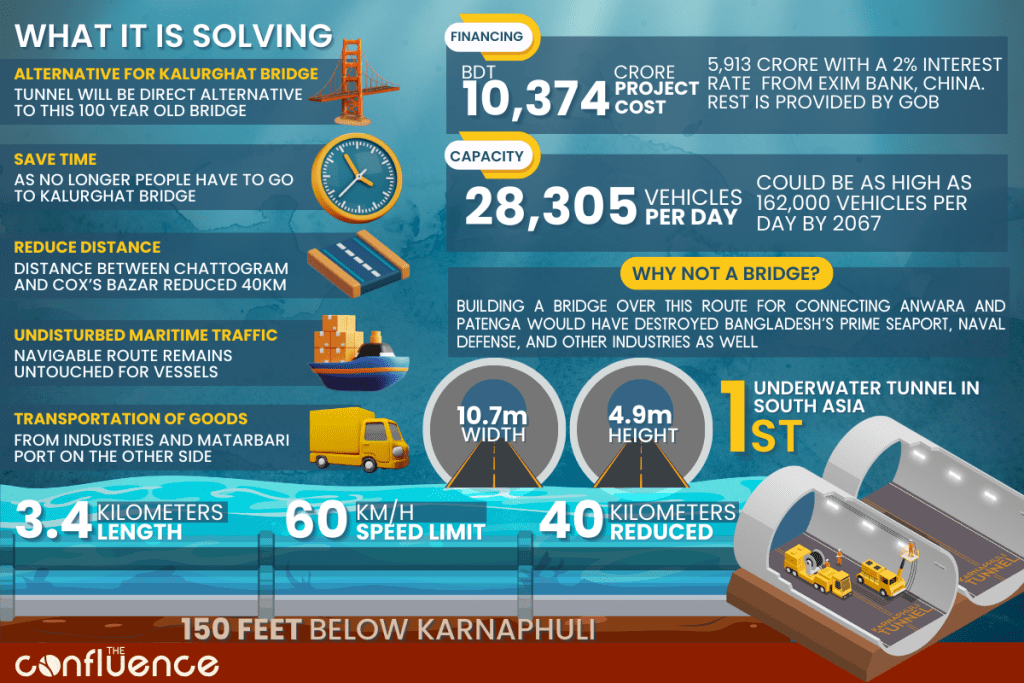
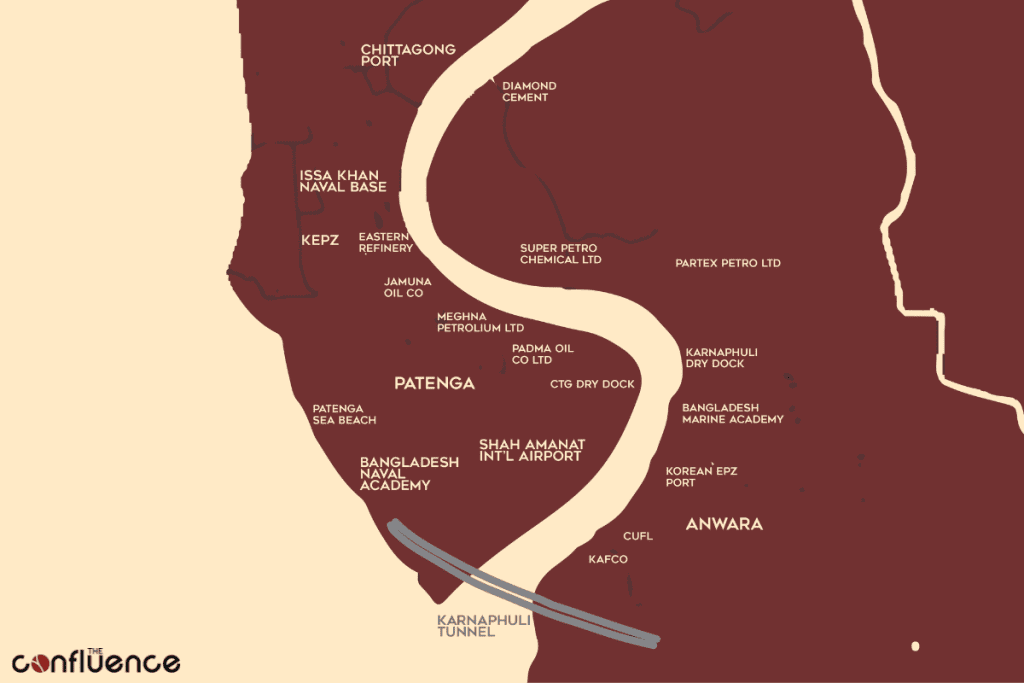
3 comments
Good and informative article on development project.
[…] Transforming Bangladesh’s Urban… Questioning the Rationale of Imposing Age Limit for… Karnaphuli Tunnel : The Case for Bangladesh’s First… Menstrual Hygiene Management: Destigmatization for Development Bangladesh’s Airbus Deal : […]
[…] Rail Is Transforming Bangladesh’s Urban… Dhaka Elevated Expressway: The Essentials Karnaphuli Tunnel : The Case for Bangladesh’s First… Questioning the Rationale of Imposing Age Limit for… Behind the Success of Female Education […]